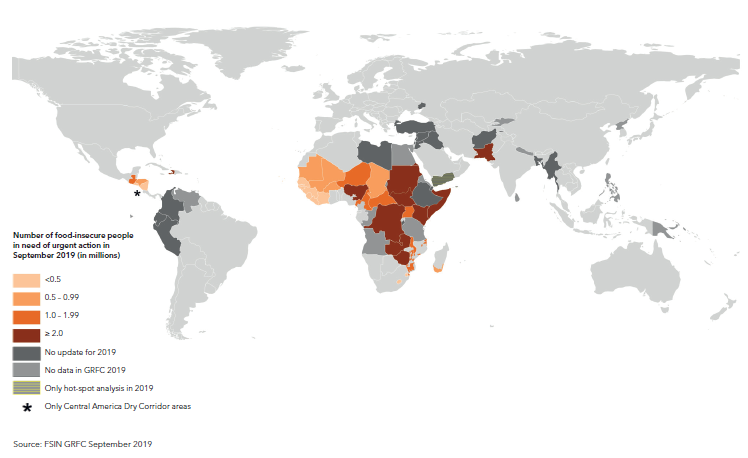The September 2019 update of the Global Report on Food Crises provides estimates of the peak number of people in urgent need of assistance for food, nutrition and livelihood support in 2019 from the first eight months of the year. Updated data were available for 36 countries and territories over the 53 countries and territories reported in the 2019 Global Report on Food crises released in March 2019.
Important data gaps include five of the eight worst food crises. Afghanistan, Ethiopia and the Syria did not have updated information, while the information from Yemen and the Democratic Republic of the Congo are not comparable with the estimates reported in the 2019 Global Report on Food crises released in March 2019.
Yemen continues to be the world’s largest food insecurity crisis in 2019. More than half of the country’s population, 15.9 million people, were classified in need of food, nutrition and livelihood assistance in January 2019 (IPC Phase 3 or above), even when taking into account the mitigating effects of food assistance. About 64 000 of them in 45 districts were facing Catastrophe (IPC Phase 5).
The food insecurity crisis in the Democratic Republic of the Congo deteriorated with 26 percent of the population analysed in Crisis (IPC Phase 3) and Emergency (IPC Phase 4) in the latter half of 2019 compared with 23 percent for the same period the previous year.
In South Sudan, during the period May to July 2019, the number of people estimated to face Crisis or worse (IPC Phase 3 or above) levels of acute food insecurity was the highest on record, both in absolute numbers (6.96 million) and as a proportion of the population (61 percent). An estimated 21 000 people were expected to be in Catastrophe (IPC Phase 5) by the middle of the year.
The Sudan food insecurity situation has remained relatively unchanged. Despite favourable 2018/2019 crop and livestock production around 5.9 million people still need urgent humanitarian food and nutrition support in the Sudan as the country faces a deepening economic crisis and political instability
In the rest of East Africa widespread drought conditions during March and most of April 2019 have affected production prospects for the 2019 main crops, namely in conditions in Somalia, Ethiopia, Kenya and Uganda, and degraded pasture.
In most Southern African countries, acute food insecurity levels remained high or worsened because of severe drought and the two cyclones.
In West Africa, increasing insecurity in Burkina Faso, Mali and the Niger in Central Sahel keep straining the food security situation. The need for food assistance is increasing among the displaced population, while humanitarian access is becoming increasingly challenging.
Acute food insecurity levels deteriorated across the Central American Dry Corridor (Guatemala, Honduras and El Salvador) between November 2018–March 2019 and February–July when almost 2 million people were in Crisis (IPC Phase 3) conditions.
| Year of publication | |
| Publisher | Food Security Information Network (FSIN) |
| Geographic coverage | Democratic Republic of the CongoIvory CoastSenegalSierra LeonePakistanMozambiqueNigeriaNigerNicaraguaYemenZambiaZimbabweUgandaSudanEswatiniSouth SudanSomaliaSyrian Arab republicMauritaniaCape VerdeCentral African RepublicChadCameroonBurkina FasoAfghanistanCongo [Republic]MalawiMaliMadagascarLesothoLiberiaKenyaGambiaEl SalvadorEthiopiaGuinea-BissauHaitiHondurasGuatemalaGuinea |
| Originally published | 15 Oct 2019 |
| Knowledge service | Metadata | Global Food and Nutrition Security | Food security and food crises |
| Digital Europa Thesaurus (DET) | food safetyfood securitymalnutritionnutrition |
Share this page

